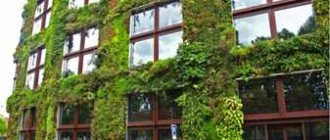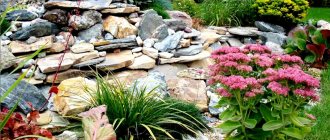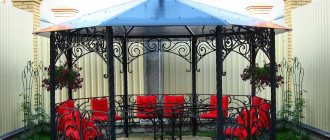A gazebo covered with plants is a very comfortable place to relax in the fresh air. It will delight the eye in the warm season and will become a favorite place for home gatherings. A gazebo will bring even more positive emotions if its walls are covered with green plants. They perform several functions at once:
- Wide leaves will create a pleasant cool shade in the heat.
- Greenery and bright flowers around the gazebo will decorate it and give it a neat and finished look.
- Overgrown plants will become a screen and create the illusion of privacy.
But in order for the gazebo to become truly beautiful, you need to know a few tricks.
Rules for selecting plants
A beautiful, light summer structure does not always require plants. Sometimes a gazebo is good without curly branches around it. If the building is intended for a beautiful view and is located on a hill, then it would be appropriate to plant small (up to 60 cm) plants at the entrance.
Their choice depends on taste, but it is preferable to plant perennial plants. As they grow, they will delight the eye every year.
When choosing climbing plants, you will need to take into account the likelihood of regular care for them.
- If you have the opportunity to devote a lot of time to caring for plants, you can plant whimsical perennials that require constant watering and feeding. They will be highly decorative and turn the gazebo into a work of garden art.
- If you don’t have time for complex care, it is better to plant unpretentious perennial plants that will create shade in the heat and will delight the eye with beautiful foliage from early spring to late autumn.
- In the first year, annual vines are also planted. They grow quickly and will decorate the gazebo while the perennials are just gaining strength. But you will need to ensure that these plants do not take up too much space.
Tree pliers round-leaved
The growth rate and high winter hardiness make this type of tree vine very attractive for landscaping the walls of gazebos and creating green arches. It grows up to 7 meters in length and blooms in May for about a week and a half.
Treepick Berries
In autumn, orange-red berries look very impressive against the background of yellow foliage. The name “Tree Plier” fully corresponds to the properties of the plant: the vine should not be planted next to fruit trees, since it wraps itself so tightly around the trunk that it destroys the plant.
Important! The fruits of the rotundifolia tree are poisonous, but their occurrence can be easily prevented by planting only male or only female plants.
We plant unpretentious perennials
They do not require significant care; they are pleasing to the eye with decorative leaves from early spring until frost. These perennial climbing plants for the gazebo do not bloom for a long time, but they grow very well and have beautiful decorative foliage.
Panthenocissus
Panthenocissus (maiden, wild grapes) is unpretentious in care and only requires increased watering in the year of planting. In the future it grows well and does not require care. The large leaves create excellent shade in the heat, and by autumn they take on a beautiful purple hue.
Maiden grapes grow well both in the sun and in the shade, so these are the No. 1 plants for the gazebo without additional care. The scourges are trimmed starting from the second year. It is frost-resistant and does not require shelter for the winter.
Evergreen ivy.
There are 15 known species of garden ivy, which differ in leaf shape. Its main advantage is that this plant grows well in the shade. Ivy is planted around the gazebo if it is located in a shaded area. Since it is evergreen, its greenery pleases the eye all year round, and it is winter-hardy.
The plant requires constant, moderate watering. Frozen and dried stems need to be trimmed at the beginning of summer, not in spring; the shoots beautifully entwine the structure and are decorative.
Root climbing vines
Representatives of this group of climbing perennial plants require high air humidity and a shady place for growth and development.
Hydrangea petiolate
Petiole hydrangea (lat. Hydrangea petiolaris Siebold & Zucc.) is a frost-resistant, slow-growing species with white flowers. They gather in large inflorescences with a diameter of about 25 cm. Flowering lasts from June to early August. Like other root-climbing vines, hydrangea clings to support with specialized roots - suckers. Young shoots must be earthed up for the winter. This will prevent them from freezing.
Ivy
Ivy (lat. Hedera L.) is a vine that requires a warm and humid climate for its growth and development. But it can also be grown in central Russia. Some varieties will need to be covered for the winter, while others will need to be dug up and transferred to a warm room for storage until spring.
Beautiful plants for the gazebo, difficult to care for.
If you select perennial flowers for the gazebo, you will need to be in the mood for meticulous care for them. Curly flowering vines can create very beautiful decorations, but they will require a lot of effort.
Among the most commonly used flowering vines will be:
Climbing roses.
For gazebos, varieties without thorns and long flowering are chosen. Rose requires constant and complex care. In order for beautiful flowers to delight from spring until the first frost and beautifully entwine the gazebo, you will need constant feeding (2 times a month), moderate, stable watering, and loosening the soil.
Roses grow well in open areas, so they need to be planted where there is at least 6-7 hours of sun per day. Rose vines require proper pruning and shelter for the winter; they are removed and covered with fallen tree leaves.
Clematis.
A large family of clematis deservedly received a residence permit in the gardens. They have long lashes (up to 7 m). The plant is cold-resistant, tolerates frost well and does not require shelter. The flowers have very different diameters from 3 to 15 cm, and the range of colors is very wide - from white to all shades of red, lilac and blue.
However, at the beginning of spring, the leaves bloom slowly and, when choosing plants for landscaping the gazebo, it is worth planting roses with them, which will bloom earlier, or take care of unusual trellises that will beautifully braid clematis.
Clematis should be planted in the sun; they bloom poorly in the shade. In order for this climbing plant to delight with its flowers from spring until the end of summer, it will require proper care: constant watering, repeated application of fertilizers (2 times a month), loosening the soil. The roots can dry out in the sun, so they require shading.
"Edible" varieties
Some summer residents prefer to see not only the green component, but also decorative elements in the natural decoration of the gazebo.
Decorative pumpkin
Many varieties of decorative pumpkin fruits are inedible. However, pumpkin fruits, unusual in shape and color, can surprise guests. Completely dried fruits can be used in kitchen design, creating various compositions.
Among the varieties we especially note:
- The “Orange” variety, both in shape and in its bright orange color, reminiscent of this fruit.
- Small snow-white pumpkins of the “Baby Boo” variety.
- Multi-colored yellow-green pear-shaped fruits of the “Kleine Bicolor” pumpkin variety.
You can grow pumpkin from seeds and seedlings. The plant is not demanding when caring, the main thing is to install a strong support.
This pumpkin has several types of varieties.
Actinidia
Actinidia is an unusual shrub vine, known and loved by gardeners for its unique fruits that resemble kiwi. In addition to the sour taste, juiciness and aroma, they contain a large amount of vitamins. Housewives often use actimidia fruits for homemade preparations for the winter. Actinidia is beautiful in all periods: in the spring young green leaves bloom, in the summer it pleases with the abundant aroma of flowers, in the fall it decorates the garden with a red-brown palette of foliage.
It is better to plant seedlings in the spring in soil prepared in advance with fertilizer, laying drainage at the bottom. Watering is moderate.
Akebia
This plant is not widespread in Russia and can be classified as a rare climbing decoration for garden verandas. Large bright purple flowers bloom in early spring, collected in inflorescences. The fruits of the vine are similar to mangoes, and their purple color is similar to plums. Akebia is famous for its exotic fruits; they taste sweet and fleshy.
Any soil is suitable for planting, but the location chosen for akebia should exclude direct sunlight. Shadow or diffused light is the best option. The liana loves abundant and regular watering throughout the season.
Cuttings for planting can be purchased exclusively from large, renowned nurseries.
Choice of neighbors
Placing plants with the same root system next to each other results in intertwining of root shoots. As a result, the plant decor may wither. Tangled roots do not grow and lack nutrients.
Fast-growing climbing annuals for fences create shade, which should be taken into account when planting garden crops.
How to achieve maximum effect
All buildings on a personal plot will be even more beautiful if they are decorated:
- flowers,
- bushes,
- vines,
- various climbing crops.
Note! When decorating a structure for outdoor recreation, you must remember that all crops growing next to the gazebo change its appearance. Not only the vines entwining the structure with their thick thickets, but also those planted near the structure.
Effectively decorating a gazebo with your own hands using climbing greenery is not a difficult task
Fire beans (Turkish beans)
The rich red flowers of this bean variety contrast very effectively with the emerald carpet of stems and leaves. Like most creeping plants, Turkish beans do not tolerate transplantation well, so the plant is sown directly into the ground. This usually happens in early May, as soon as the threat of return frosts disappears. Ornamental beans love sunlit areas and neutral and slightly alkaline soils. If necessary, add ash or lime to the soil before planting. Beans grow very quickly, and if they are not trimmed in a timely manner, they can grow up to 3 m. To prevent the plant from stretching, even before flowering begins, the main stem should be periodically trimmed to the height of the supports. An additional advantage of this plant is its ability to bear fruit. The first young pods can be collected within 35-40 days after sowing the seeds.
| Plant | Sowing time | Flowering period |
| Fire red beans | May – in open ground | From July until the first frost |
Summary
Vertical gardening is one of the most convenient and common options for landscaping an area. A green blanket of plants will protect from the scorching sun, prying eyes, wind, and dust. An important fact is that planting vines does not require a lot of space.
On a note! With the help of vertical gardening you can hide the flaws of the building.
Well, the video in this article will offer many more interesting things on the discussed topic, watch it!
Did you like the article? Subscribe to our Yandex.Zen channel
Ways to create an attractive design
For landscaping the gazebo and the area near it, you can use:
- Flowers.
- Bushes.
- Climbing plants.
- Tenacious vines.
It is worth noting that you can use one of the landscaping methods, or several, intelligently combining them with each other. At the same time, you need to remember that any decoration of the resting place with growing crops will completely change the appearance of the gazebo, so you need to imagine the future picture and decide whether it fits the surrounding landscape design and its style.
Decorative pumpkin
This plant will undoubtedly appeal to lovers of non-standard and exotic solutions. They grow it in the same way as a regular one, with the only difference that they must provide the plant with strong and stable support. Unpleasant news for those who would like to kill two birds with one stone: decorate the gazebo and enjoy pumpkin porridge - the fruits of this vegetable do not taste very pleasant, and you can eat them only as long as the skin remains soft. Decorative pumpkin grows very quickly: planted in early May, by mid-summer it will have grown so much that its thick green carpet will hide the entire fabric of a fence or supporting wall. Seeds for seedlings are sown at the end of April in peat tablets or separate small cups. This vegetable is very thermophilic, so seeds are sown in open ground closer to mid-May, when the air temperature rarely drops below 12-14°C.
| Plant | Sowing time | Flowering period |
| Decorative pumpkin | April - for seedlings, May - in open ground | July-October |
- Everything about pumpkins: from choosing seeds to storing the harvest
Didn't your pumpkins grow last year? No problem! We will teach you to avoid common mistakes in growing vegetables, so that in the new season you will not be ashamed of your harvest.
If you have a gazebo on your site that needs to be made more cozy and elegant, or a fence that is still strong and reliable, but no longer so attractive in appearance, climbing plants will come to the rescue. Perennial vines could cope with this task, but it will take more than one year for them to transform the garden area. The ideal solution to this problem would be to use climbing annuals. In just one season, you can hide your gazebo from prying eyes or radically update the appearance of the building.
The most popular climbing annuals for the garden
The best varieties of annual loaches are:
- Fire red beans . It is distinguished by bright and original inflorescences and large leaves. Grows more than 3 m. Blooms from the end of July. Loves regular watering and fertilized soil. Bell flowers emit a pleasant honey aroma. Height – 3 m.
- Dolichos (aka climbing lilac, hyacinth bean). It is distinguished by its bright colors and elegant purple-white inflorescences. Blooms from July to September. Height - 1.5 - 3 m. In addition to abundant flowering, it pleases gardeners with a pleasant and rich aroma.
- Winged thunbergia . It has a beautiful and unusual appearance. Her flowers have a dark center and come in a variety of colors: yellow, orange, white, apricot. It reaches a height of 2 m. Loves sunny places.
Recommendations
If you want partial shade to prevail in the gazebo, and the plants shade it not tightly, but openly and lightly, and the sun filters through the thickets and the breeze blows, then planting cultivated grape varieties can be considered the optimal solution. In addition to the fact that this option will create a light shade, you will be able to grow juicy and sweet grapes (see also the article “Gazebo for grapes with your own hands: how to make it correctly”).
Grapes in a gazebo are practically instructions for combining useful and pleasant things!
In the evening, the aroma of many crops intensifies, for example:
- Petunia,
- Carnation,
- Sweet pea,
- Chubushnik,
- White tobacco and many others.
These plants will come in very handy next to the gazebo. And if you select different flowers according to timing, duration of flowering, color, that is, different types, then the gazebo will be filled with the incomparable aroma of colorful plants all summer long.
A blooming garden is the price of your hard work
landscaping element
A gazebo is a structure made of wood or metal, brick or other building material. The main function of the building is to create comfortable conditions for outdoor recreation. Here you can be alone or gather a noisy company - it’s a matter of taste and preference of the homeowner. However, the gazebo should not be boring, because a platform entwined with green plants looks much more beautiful. The main question that worries summer residents is what crops to choose for landscaping the gazebo?
As practice shows, perennial flowers are used to decorate the structure, with which you can decorate not only the gazebo, but also the defects of a private house, felled trees, etc. By planting climbing flowers in your dacha, you can “envelop” an extension or fence, creating a living corner that beckons with its beauty. Lianas grow quickly, so they can easily hide vacationers in the gazebo from prying eyes; in addition, they protect from the sun and wind and create a shady space.











